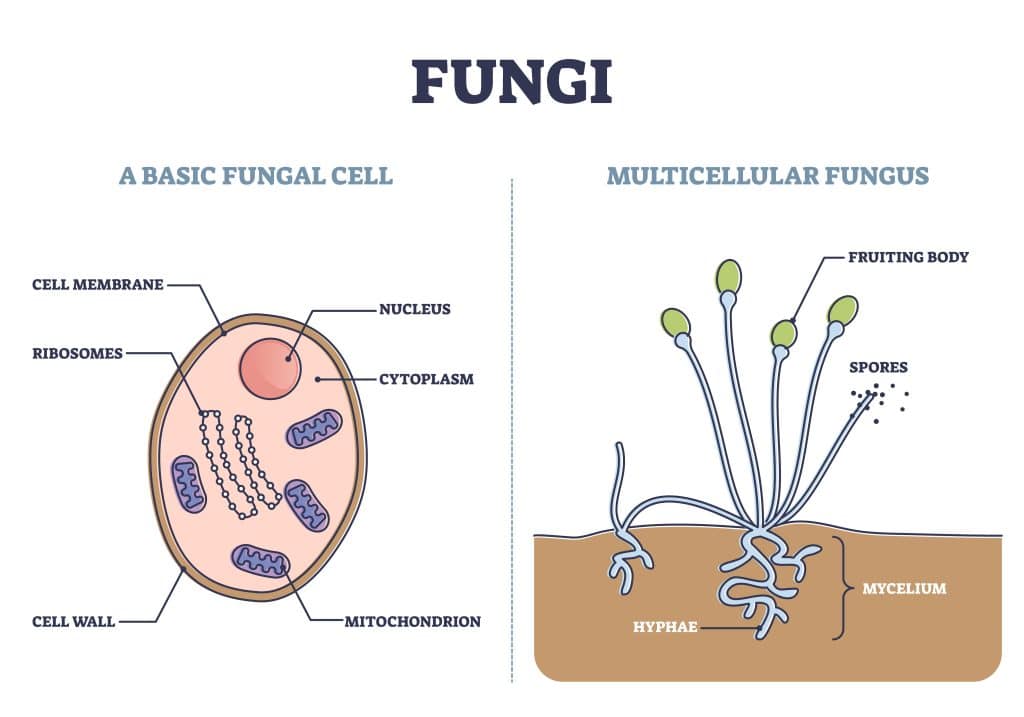Section 4: Fungi
 Fungi, a diverse kingdom of organisms ranging from microscopic molds to towering mushrooms, play a crucial role in ecosystems worldwide. Most fungi are eukaryotes with cell walls made of chitin, similar to that found in an insect’s exoskeleton. Chitin forms a rigid cell wall that helps the fungi retain their shape. Fungi, except for the simplest yeasts, have cells arranged in structures called hyphae. Hyphae are made up of tiny threads of cytoplasm surrounded by a plasma membrane.
Fungi, a diverse kingdom of organisms ranging from microscopic molds to towering mushrooms, play a crucial role in ecosystems worldwide. Most fungi are eukaryotes with cell walls made of chitin, similar to that found in an insect’s exoskeleton. Chitin forms a rigid cell wall that helps the fungi retain their shape. Fungi, except for the simplest yeasts, have cells arranged in structures called hyphae. Hyphae are made up of tiny threads of cytoplasm surrounded by a plasma membrane.
Fungi employ a remarkable feeding technique in which they absorb nutrients through the hyphae. This external digestion process allows fungi to access nutrients from a wide range of sources, including dead plant material, animal remains, and even living organisms, allowing them to thrive in diverse habitats. As they grow, the hyphae of a fungus branch form a mass called a mycelium, the body of the fungus.
 Fungal reproduction predominately relies on the formation and dispersal of spores. The lightweight spores are surrounded by a protective covering and can easily be carried through air or water to new sites. Spores in reproductive structures are called fruiting bodies, which fungi can reproduce asexually or sexually. Asexual reproduction typically involves the formation of spores through mitosis, where genetically identical offspring are produced from a single parent organism. On the other hand, sexual reproduction in fungi involves the fusion of reproductive cells from genetically compatible organisms.
Fungal reproduction predominately relies on the formation and dispersal of spores. The lightweight spores are surrounded by a protective covering and can easily be carried through air or water to new sites. Spores in reproductive structures are called fruiting bodies, which fungi can reproduce asexually or sexually. Asexual reproduction typically involves the formation of spores through mitosis, where genetically identical offspring are produced from a single parent organism. On the other hand, sexual reproduction in fungi involves the fusion of reproductive cells from genetically compatible organisms.
Fungi are heterotrophic organisms relying on external food sources to sustain themselves. The feeding relationships of fungi encompass a variety of interactions from parasitism, where fungi use host organisms for nutrients, to mutualism, where both organisms benefit, and decomposition, where fungi play an important role in breaking down organic matter.
Parasitic fungi establish intricate feeding relationships with host organisms. For instance, the cause of the Great Potato Famine in 1845 was an airborne fungus originally transported in the holds of a ship traveling from North America to England. Another example can be seen in Ophiocordyceps uniateralis, also known as “zombie fungi” which infects and controls an ant to move to suitable growing conditions for the fungi. Eventually, the ant dies, and a stalk grows from its head, releasing spores to infect other ants in the colony. Finally, athlete’s foot is a very common irritating skin condition that affects the sole of the foot and the skin between the toes.
Mutualistic fungi engage in relationships that benefit both organisms. Mycorrhizae are symbiotic relationships between fungal hyphae and plant roots. The fungi increase the plant’s absorption of water and minerals. The sugars produced by the plant, in turn, nourish the fungi. Additionally, Caperat lichen consists of millions of algal cells within a mesh of fungal hyphae. The photosynthetic algae nourish the fungus, while the fungal mycelium, in turn, offers an environment for the algae to thrive.
Decomposing fungi is important in ecosystems, contributing greatly to soil health and nutrient cycling. For instance, the scarlet elf cup thrives on decaying woody material, often making a distinctive “puff” sound when releasing its spores. Additionally, Turkey Tail is a colorful bracket fungus that sustains itself for an extended period on decaying trees, sometimes displaying colorful concentric rings indicative of annual growth cycles. Moreover, the average mushroom-loving person eats about two pounds of the fungus called the white button mushroom. They contain B vitamins, selenium, potassium, and other important vitamins and minerals.
There are three major groups of fungi: club fungi, sac fungi, and zygote fungi. Club fungi, like mushrooms and puffs, produce spores in club-like structures. Sac fungi, like yeasts and truffles, produce spores in sac-like structures. Finally, zygote fungi, like fruit and bread molds, produce very resistant spores and can stay dormant for long periods.
Review:
- What is chitin?
- Explain the structure of the body of a typical fungus.
- Identify characteristics of club fungi.
